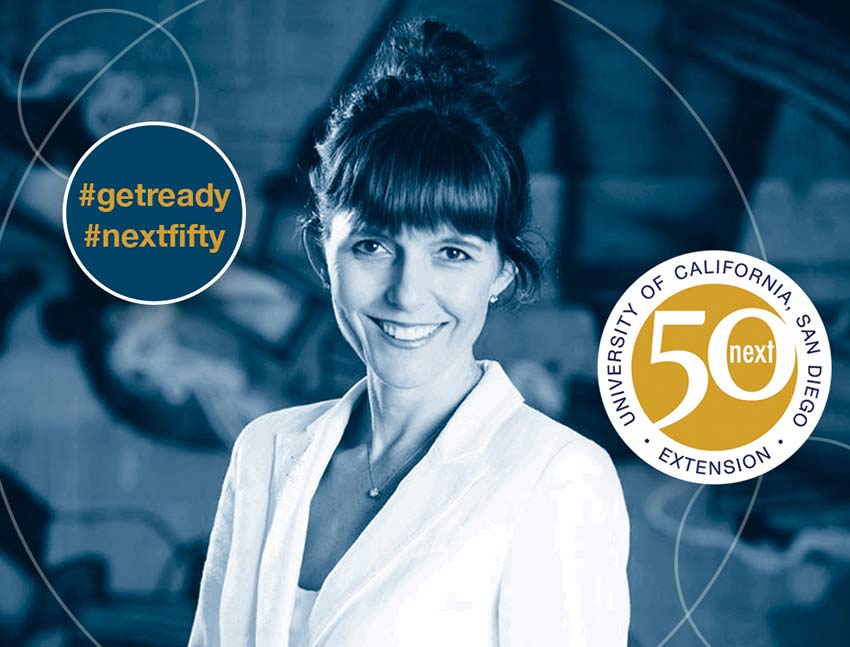1 November 2016
50 Voices of the Future: Stacey Pennington on revitalizing East Village

In honor of UC San Diego Extension’s first 50 years, 50 Voices of the Future asks thought leaders about the trends, breakthroughs and social advances they foresee over the next 50 years.
San Diego’s Downtown is in the midst of an urban renewal as it looks to transform itself into a hub for innovation, culture and community connections. Stacey Pennington, a principal at SLP Urban Planning, has long been a driving force in the effort to revitalize the Downtown neighborhood. Currently, Pennington is part of the team working on Makers Quarter, a six-city block mixed-use district in the East Village that aims to create a vibrant economic and residential neighborhood that will power the region’s prosperity for generations to come.
Why is the work you do important?
As an urban planner, I have the opportunity to help shape the future of cities and the built environment, more specifically focusing on the East Village neighborhood in Downtown San Diego and Makers Quarter. The future of the built environment really drives and helps shape the quality of people’s lives and the opportunities that the next generations will have to fulfill their goals and dreams. That, paired together with issues of sustainability and our nation’s infrastructure and growth patterns over the past several decades, makes the field of urban planning even that much more significant.
What are the influential/exciting developments happening in your field now and why?
The rapid transformation of how we live our day-to-day lives with the influence of technology affects us in many ways. And professionally, it affects the world of urban planning, design, building and architecture. Technology has created a field of interest within urban planning relating to smart cities, which has many layers but is a very scalable concept. It relates just as much to the future of unmanned vehicles as it does to how the region plans for systems of transportation, energy and communication.
Those two things interact with the broader city and urban environment where potentially the mechanisms behind everything can speak to one another. That’s very exciting, especially as it relates to goals of sustainability because of the efficiencies and energy use that can otherwise be measured and improved.
Another exciting development is the increasing importance of civic involvement and how cities are planned, designed and built, all while incorporating the application of human centered design principles.
What’s the next big thing?
One of the great things about urban planning is its’ diversity – an urban planner can be focused on the scale of a region, city or block and through the lens of transportation + mobility, open space + connectivity or community engagement, among many other areas. One thing that I have been very focused on is shifting away from traditional models for community engagement, which might include a series of town hall style meetings on a particular topic, towards a much more interactive and iterative approach known as Tactical Urbanism, where ideas and concepts are ‘tested’ in an interim nature and, the ones that work, shape the future, while the ones that don’t, we learn from early. This approach is instrumental to many of the scales of urban planning and is just now getting broader traction throughout the City and Region. I really see the next big thing being a gradual and incremental transition towards a more thoughtful and genuine model for civic engagement that can be applied across multiple scales, whether it is similar to the approach taken in Makers Quarter, at the scale of six blocks in Downtown, or at a much broader, infrastructure driven scale.
How big an impact will your field play in shaping the future of the San Diego region and beyond?
I see urban planning through a very holistic lens where it’s incredibly intertwined with issues like economic development – I believe that it will be one of the most important fields in determining the future of our region. The strength of San Diego’s innovation economy and it’s potential to grow heightens the importance of creating environments for it to flourish. While we are known for our beauty, we are also creating a rich and diverse Downtown environment suited to provide the infrastructure, culture, education, open space and density needed for a promising future.
Hop in to your time machine … what does the future look like for this field in 50 years? How can individuals/companies get prepared for what’s next?
The future will be intertwined with technology in ways that we can’t even begin to imagine. In the future, I think urban planning will follow a similar trajectory for the role it played many decades ago. I think the same pattern will continue and it will intensify and be expedited. Urban planning went from being an integral but separate field, and today it’s incredibly intertwined with all issues on every scale. I think that 50 years from now, the way people live their lives and the central role of technology and the growth of cities will be completely intertwined.
We have a wide range of Environment & Sustainability offerings. Learn more about the UC San Diego Extension Urban Planning & Preservation courses and programs on our website.